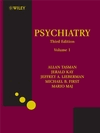Emotions
Summary
The experience of emotion occurs through a set of expressive behaviors, the function of the nervous system, and cognitive perception or appraisal. The basic patterns of emotional expression are present at birth and vary little with age and across cultures. The frontal lobe is involved in the process of interpreting the emotions of others. The temporal lobe, and in particular the amygdala, has a role in the perception of emotion. Two terms used to refer to an individual's emotion in the psychiatric mental status examination are affect and mood. Affect fluctuates, whereas mood is a more pervasive and sustained emotional state. Anxiety is an emotion characterized by apprehension and anticipation of future danger or misfortune accompanied by a feeling of dysphoria or somatic symptoms of tension. Depression refers not only to an emotional state that is characterized by brief or mild periods of sadness or being “down” but also to a clinical condition characterized by depressed mood. A sense of helplessness or loss of self-esteem is often present in a depressed mood. Euphoria is defined as intense elation often associated with feelings of grandeur. Apathy is characterized by a dulled emotional tone associated with detachment or indifference. It is the patient's described and observed emotion that allows the psychiatrist to properly distinguish and subsequently make a diagnosis of disorders that are related to anxiety, depression, euphoria, apathy, hostility, and anger.



